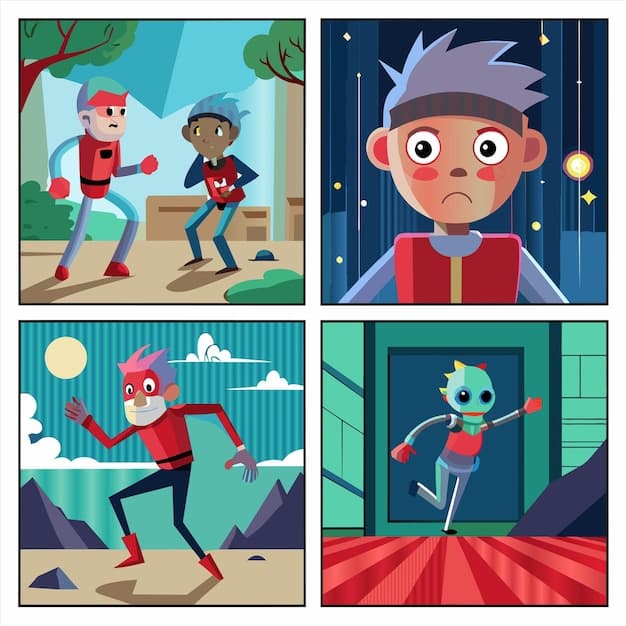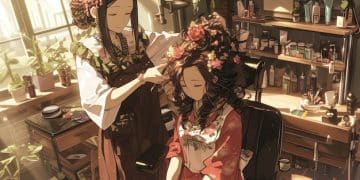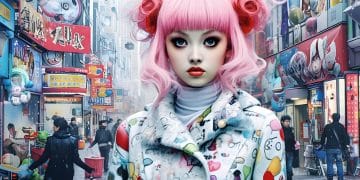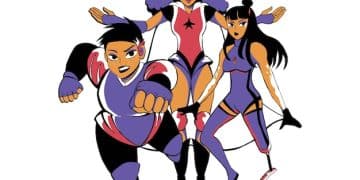Anime’s Impact on US Animation: Trends and Influences

The impact of anime on US animation is evident in recent trends, influencing art styles, storytelling techniques, and the overall diversity of animated content, reflecting a growing global exchange of creative ideas.
The lines between Japanese anime and American animation have blurred in recent years, leading to a fascinating exchange of ideas and techniques. This article explores the impact of anime on US animation: a look at recent trends and influences, examining how it has reshaped the landscape of American animated content, from stylistic choices to narrative approaches.
Anime’s Growing Popularity in the US
Anime’s popularity in the United States has surged exponentially in recent decades, evolving from a niche interest to a mainstream phenomenon. This growth is fueled by increased accessibility through streaming platforms and a broader cultural acceptance of diverse animation styles.
Rise of Streaming Services
Streaming platforms like Netflix, Crunchyroll, and Hulu have played a pivotal role in making anime readily available to American audiences. These services offer vast libraries of anime titles, catering to a wide range of tastes and preferences.
Cultural Acceptance and Fandom
Beyond accessibility, anime’s increasing cultural acceptance has contributed to its mainstream appeal. Anime conventions, cosplay events, and online communities have fostered a vibrant fandom, further amplifying its popularity.
- Easier and wider access of anime content
- Appeal to a wider audience due to diverse genres and themes.
- Anime conventions and communities that foster fandom.
The widespread availability and increasing acceptance of anime have laid the groundwork for its significant impact on US animation, influencing both creators and consumers alike.

Art Style and Visual Influences
One of the most noticeable ways anime has impacted US animation is through its distinctive art style and visual techniques. American animators are increasingly incorporating elements like expressive character designs, dynamic action sequences, and detailed backgrounds.
Expressive Character Designs
Anime is known for its expressive character designs, featuring large, emotive eyes, unique hairstyles, and detailed costumes. These elements have made their way into American animated shows, adding depth and personality to the characters.
Dynamic Action Sequences
The influence of anime can also be observed in the dynamic and fast-paced action sequences seen in many American animated series. Animators are drawing inspiration from anime’s fluid movements and creative choreography.
- American animation adapted more expressive character designs
- Dynamic perspective and camera movements inspired by anime.
- Incorporation of super deformed for comedic effect
These visual influences have enriched the overall aesthetic of American animation, making it more visually appealing and engaging for audiences.
Narrative and Storytelling Techniques
Beyond visual aesthetics, anime’s impact extends to the narrative and storytelling techniques used in US animation. American creators are adopting complex plot structures, character-driven narratives, and thematic explorations that are characteristic of anime.
Complex Plot Structures
Anime often features intricate plotlines with multiple layers and intertwining storylines. This approach has inspired American animators to create more sophisticated and engaging narratives for their audiences.
Character-Driven Narratives
Many anime series focus on character development and emotional depth, allowing viewers to connect with the characters on a deeper level. American animators are embracing this approach to create more relatable and compelling characters.
Anime storytelling is known for complex themes and emotional depth.
Anime series can be long with over arching plots that keep viewers interested.
Character growth over a period of time. Characters face moral dilemmas forcing them to grow.
By incorporating these narrative techniques, American animation is offering viewers more immersive and thought-provoking experiences.

Thematic Exploration and Genre Diversification
Anime’s influence on US animation can also be seen in the diversification of themes and genres explored in American animated content. Anime has opened the door for American creators to tackle mature and complex themes such as identity, morality, and social issues.
Mature Themes and Social Commentary
Anime often tackles mature themes such as war, death, and social inequality, providing a platform for discussing complex issues. American animators are increasingly incorporating these themes into their own works, creating more meaningful and impactful stories.
Genre Diversification
Anime encompasses a vast range of genres, from science fiction and fantasy to romance and slice-of-life. This diversity has inspired American animators to experiment with different genres and subgenres, resulting in a broader spectrum of animated content.
- Exploration of Identity and Belonging
- Tackling complex social issues.
- Blending genres to make unique stories for viewers.
These thematic and genre diversifications have broadened the appeal of American animation, attracting new audiences and pushing the boundaries of what animated content can achieve.
Examples of Anime-Influenced US Animation
Several American animated shows have openly embraced anime influences, showcasing the growing interconnectedness between the two animation styles. These examples demonstrate how anime’s impact is translating into tangible changes in US animation.
Avatar: The Last Airbender
One of the most prominent examples of anime influence in US animation is “Avatar: The Last Airbender.” The show incorporates many elements of anime character design, action sequences, and storytelling.
Steven Universe
“Steven Universe” is another American animated series that draws inspiration from anime. The show features expressive character designs, dynamic action sequences, and a focus on character relationships, a common theme in anime.
RWBY displays how anime has influenced American animation.
Children shows like Teen Titans Go display a more exaggerated art style.
These examples highlight the successful integration of anime influences into American animation, resulting in critically acclaimed and commercially successful series.
Future Trends and Collaborations
The future of US animation is likely to see even more collaboration between American and Japanese creators, leading to further integration of anime influences. These collaborations have the potential to generate creative and innovative animated content.
Co-Productions and International Projects
Co-productions and international animation development projects between American and Japanese studios are becoming more common, fostering greater understanding and exchange of ideas and techniques. These collaborations can result in unique and compelling animated works that appeal to a global audience.
Cross-Cultural Inspiration
As anime continues to gain popularity in the United States, cross-cultural inspiration will become more prevalent in US animation. American creators will continue to draw from anime’s rich artistic and narrative traditions, resulting in a more dynamic and diverse animation landscape.
- Increasing co-productions between American and Japanese studios.
- Growing number of American creators drawing inspiration from anime.
- Greater diversity and innovation in animated content.
These future trends suggest that anime’s impact on US animation will only continue to grow, shaping the future of animated content for years to come.
| Key Aspect | Brief Description |
|---|---|
| 🎨 Art Style | Anime’s expressive character designs impact US animation’s looks. |
| 🎬 Storytelling | Anime’s influence is on complex plots in American animation. |
| 🎭 Thematic | Genres in anime are now explored in US animation. |
| 🤝 Collaboration | American and Japanese creators work together. |
Frequently Asked Questions
▼
Anime has expressive characters, like big eyes, so can show a wide range of emotion. These iconic features influence animation’s storytelling from many countries.
▼
Anime stories and shows many times show character growth, and complex story plots. These storytelling techniques provide more storytelling to US animation.
▼
Anime has a lot of different shows that delve into different topics. Anime has a large range of different social issues, like inequality which opens doors to more meaningful topics.
▼
Some examples can include shows like Avatar: The Last Airbender that openly uses art styles and storytelling from anime styles. Anime’s influence is often subtle but pervasive!
▼
US animation is seeing more work with Japanese creators often. These collaborations can lead to work on creative and new animated content.
Conclusion
The influence of anime on US animation is profound, shaping art styles, storytelling techniques, and thematic explorations. As collaborations between American and Japanese creators continue to grow, the future of animation promises even more innovative and cross-cultural content.





